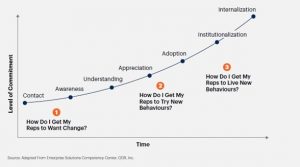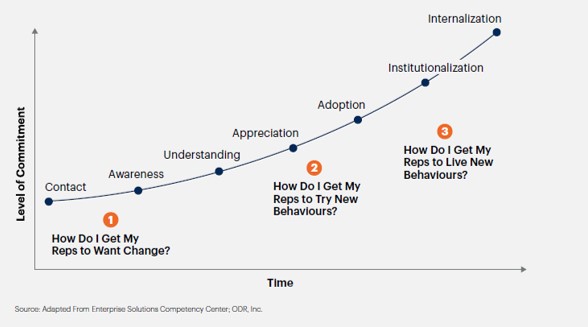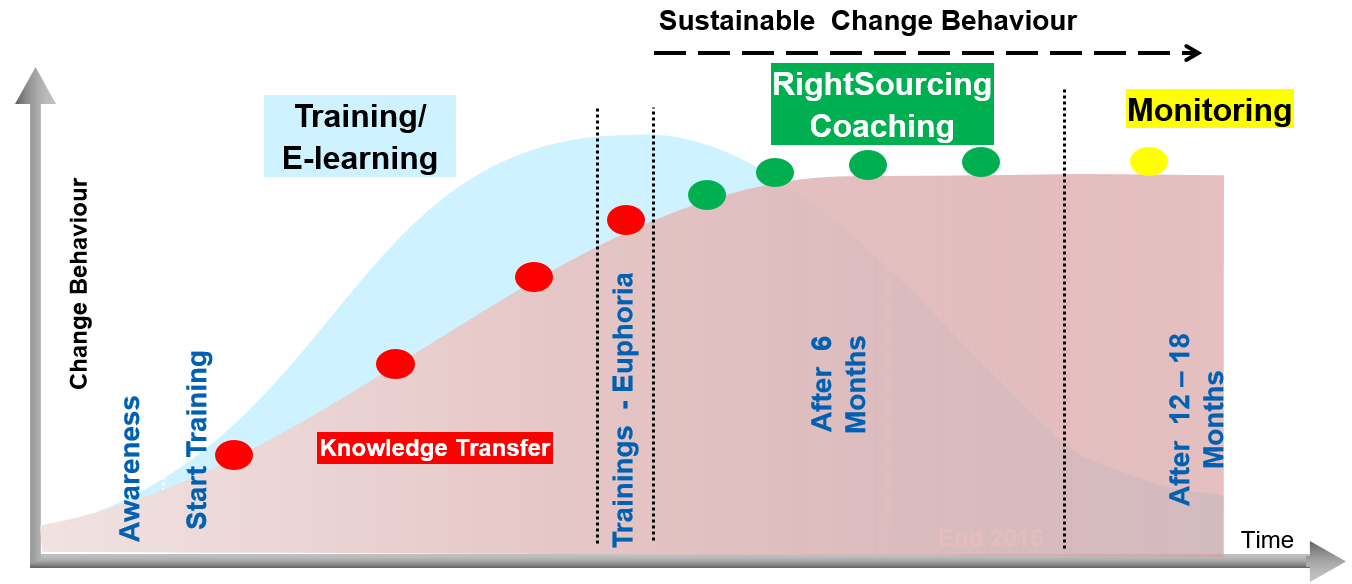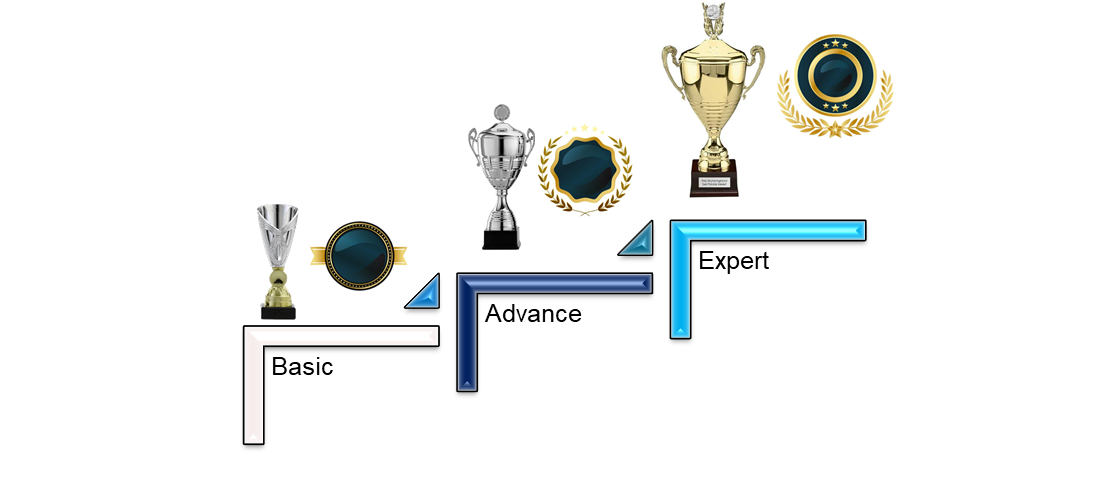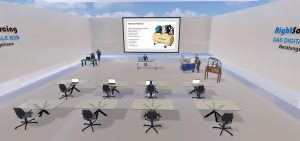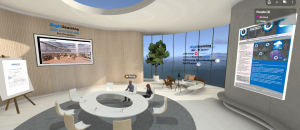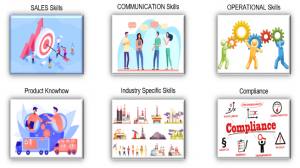- Article, English, RS Internal
- Suchi Shinde
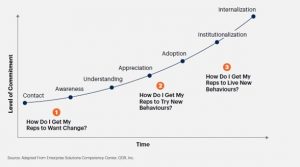
Excellence in Sales Education – Change adoption in building a Learning Organization
Welcome to this collection of articles focusing on Excellence in Sales Training. In this series, we will explore top-notch practices, the most current trends, and hands-on advice for creating and executing outstanding sales training initiatives. By doing so, we aim to progress toward the development of a self-learning organization.
A contribution by Suchi Shinde and Prof. Dr. Markus Hesse, Oct 2023
In our 3rd Article in this series, let’s explore how to implement a change initiative to further encourage adoption in the organization.
As we progress toward establishing a Learning Organization, we shift our focus from isolated sales training events to fostering lasting behavioral change. If the behaviors are ingrained and deeply integrated into the individuals, sales professionals will come back to their sales roles with the ability to apply the newly acquired behaviors from the training. Achieving this necessitates winning their commitment and conviction while offering chances for practical application. The Behavioral Adoption curve depicted below illustrates the evolving challenges that a company encounters over time while striving to establish an internalized, lasting change behavior. (Picture 1)
Picture 1: Behaviour Change Adoption Curve – Learning Organization /1/
To address the first 3 stages in the Adoption curve – Contact, Awareness, and Understanding, companies need to start with ‘Helping people want to learn’. Organizations need to assist employees in embracing the need for change and in cultivating the motivation to acquire the skills that will drive progress /2/. Prior to effectively mastering a new skill, employees must be convinced that it will enhance their organization’s performance. They also need to acknowledge any deficiencies in their own performance in that particular area, and actively decide to embark on the learning journey.
Appreciation and Adoption can be addressed by giving awards for completing the Training and Implementing the training in real-work environments. Recognition could be given at various internal events as well as on social media.
Measuring the impact. Measuring impact seems basic, but most companies simply don’t do it. McKinsey research finds that only 50 percent of organizations even bother to keep track of participants’ feedback about training programs. Worse, only 30 percent use any other kind of metric. What this means, of course, is that many companies essentially measure the effectiveness of the training by asking the participants if they liked it. Besides the risk of encouraging “edutainment” over substance, the problem with this approach is that it penalizes programs that push people outside their comfort zones. /2/ (and counterproductive to the change process)
Measuring the impact of sales training is crucial to determine its effectiveness in improving the performance of the sales team. Key Performance Indicators (KPIs) after-sales training help assess the return on investment and identify areas that need improvement. The most direct indicators of the effectiveness of sales training are an increase in Sales Revenue, Sales Volume, Average Deal size, and Sales Cycle. However, other training-relevant metrics to measure could be Sales Pipeline progress, tracking the percentage of sales opportunities that result in a win (win rate), Sales Team Productivity, Forecast Accuracy, Cross-Selling, and Upselling, etc. Measuring the level of engagement and participation in the training program could be interesting as high engagement often leads to better learning outcomes. It is obvious that for this reason generic eLearning, which can be found for little money on social media platforms, can never lead to a constantly learning organization.
Picture 2: Rightsourcing Knowledge Transfer Concept©
For Institutionalization, the key aspect is to Reinforce the new skills. Participants rarely leave any training program entirely prepared to put new skills into practice. Old habits die hard, after all, so reinforcing and supporting new kinds of behavior after they are learned is crucial. (This is integrated as a ‘Monitoring’ in the Rightsourcing Training -Coaching- Monitoring concept) (Picture 2). The first management level of a sales organization is of particular importance here. They must act in a supportive and encouraging manner in day-to-day business. The group is often not present at training sessions due to a lack of time or a misjudged level of knowledge, which means that they are unable to fulfill their role as coaches. In the Rightsourcing Knowledge Transfer Concept, special training is also provided for this stakeholder group of a sales organization.
Certification. In order to further drive Institutionalization, the tailored capability-building program should be all wrapped into a meaningful certification program. It could consist of a series of levels that can be successively built.
Picture 3: Creating a Multilevel Certification Program
Creating a multilevel certification program with (for e.g.) basic, advanced, and expert levels can be a valuable way to help individuals develop and demonstrate their skills and expertise in Sales. Each level should have predefined prerequisites, curriculum, tests, certification title, and the next development level. (Picture 3)
To earn certification for a specific level, participants should complete tailored work related to their specific customer accounts at a very granular level. They could also undertake a case study, consisting of multiple role plays and simulated exercises. The program should be focused on both developing skills and on-the-job training, not just finishing the course.
Further motivation for the Sales team could be built in at several levels. The first participants to complete the highest level of the certification program could be showered with visible praise at sales meetings and recognized through town halls and email blasts. Sales professionals should have to achieve certain certifications in order to qualify for special incentive-based compensation. The journey shouldn’t stop once a level of certification is earned. Sales professionals should have to re-certify every year, undertaking a constantly evolving training curriculum.
The world’s best sales organizations expect and equip their sales professionals to continually train and sharpen their skills.
In our next Article (#4), let us move on to discussing how to create a Self-Learning Organization and how the latest technologies can become easy enablers for this move.
References:
- n.n, Gartner for Sales – Increase the Long-Term Impact of Sales Kickoff Events, Build the ultimate agenda to put your sales team on the path to success, 2022
- Smet, A., Mcgurk, M., Schwartz, E., Getting more from your training programs, October 2010, McKinsey Quarterly
Rightsourcing Newsletter in Ihre Postfach. Melden Sie sich für unseren Newsletter an und Sie erhalten regelmäsig Updates in ihr Postfach. Natürlich können Sie ihn jedezeit abstellen.
Erhalten Sie die neuesten Updates zu Geschäftstrends und Technologie
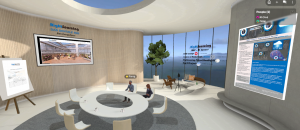
Digitale Transformation im Vertriebstraining: Auf dem Weg zur Selbstlernenden Organisation
Weiterlesen »